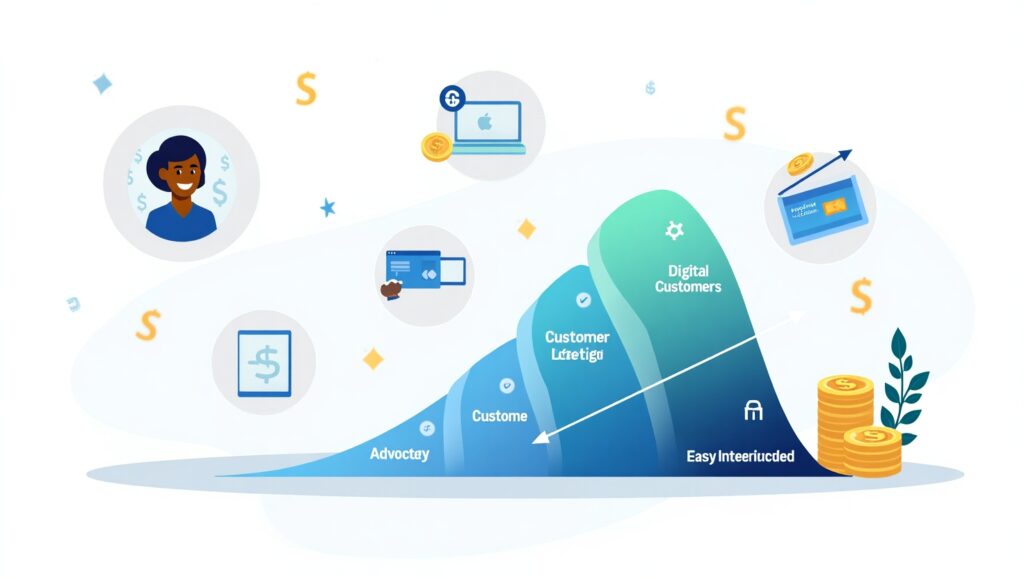Table of Contents
Customer retention is a critical driver of sustained growth, profitability, and competitive advantage in today’s finance landscape. In industries ranging from banking and insurance to personal finance and investment, the ability to keep existing customers not only reduces marketing costs but also enhances revenue through increased lifetime value. This article delves into the importance of customer retention, offering expert insights, actionable strategies, and real-world examples to empower financial professionals and business leaders to foster long-term customer relationships.
Introduction
Imagine a scenario where a 5% improvement in customer retention leads to a revenue increase of up to 25%—a reality that many financial institutions have already experienced. Customer retention is not just a buzzword; it is a cornerstone of sustainable growth and profitability. With a focus on delivering tailored financial advice and expert insights, this article explores why retaining your customer base is essential in the finance sector and how to implement effective strategies that resonate with your target audience.
In this article, we will cover:
- The definition and scope of customer retention in finance
- The financial impact of retaining customers versus acquiring new ones
- Real-world case studies and actionable strategies
- Methods to measure and enhance customer retention
- Future trends and challenges in the realm of customer retention
Also Read: The Critical Role of Financial Advisors: Why Expert Guidance Matters for Your Financial Future
Understanding Customer Retention in Finance

What Is Customer Retention?
Customer retention refers to the strategies and actions that businesses use to encourage customers to continue using their products or services. In the finance sector, customer retention involves nurturing long-term relationships, ensuring customer satisfaction, and continuously engaging with clients to build trust and loyalty.
The Scope in Various Finance Sectors
Different segments of the finance industry benefit uniquely from customer retention:
- Banking: Retention leads to cross-selling opportunities, such as mortgages, credit cards, and investment products.
- Insurance: Loyal customers are more likely to renew policies and opt for additional coverage, reducing churn.
- Personal Finance: Trusted advisory services and personalized financial planning foster deeper client relationships.
- Investing: Consistent communication and transparency encourage long-term investment and portfolio growth.
By understanding these nuances, financial professionals can tailor retention strategies to the unique needs of their target market, ensuring both short-term profitability and long-term growth.
Why Customer Retention Is Crucial

Cost Efficiency and Profitability
Acquiring new customers can be 5 to 25 times more expensive than retaining existing ones. This difference is particularly pronounced in the finance sector, where customer acquisition often involves extensive due diligence, marketing campaigns, and regulatory compliance. Key benefits include:
- Reduced Marketing Costs: Lower advertising expenditures and sales efforts are needed to maintain relationships with existing customers.
- Increased Lifetime Value (LTV): Loyal customers tend to invest more over time, enhancing overall profitability.
- Enhanced Revenue Streams: Retained customers are more likely to explore additional services, contributing to diversified revenue sources.
Building Trust and Credibility
Financial decisions are inherently personal and complex. Customers gravitate toward institutions that offer consistent value, transparency, and personalized service. By focusing on retention, companies can:
- Foster Trust: Consistent communication and superior service quality help build a trustworthy brand.
- Improve Reputation: Satisfied customers become brand advocates, sharing positive experiences that enhance market reputation.
- Mitigate Risk: Long-term relationships allow financial institutions to better understand customer needs and manage risks effectively.
Real-World Example: Banking Sector
Consider a mid-sized bank that implemented a customer loyalty program with personalized financial reviews and rewards. Over a span of three years, the bank observed a 30% increase in cross-selling opportunities, with customers opening additional accounts and investing in new financial products. This case exemplifies how an investment in retention can yield measurable financial benefits.
Strategies to Improve Customer Retention

Achieving high customer retention requires a multifaceted approach that leverages technology, personalized communication, and data-driven insights. Here are several strategies that can be particularly effective in the finance sector:
Enhance Customer Service and Communication
- Personalization: Use data analytics to tailor communication and offers to individual customer needs.
- Multi-Channel Engagement: Engage with customers through various platforms (email, mobile apps, social media) to ensure a seamless experience.
- Proactive Support: Anticipate issues and resolve them before they impact the customer experience.
Implement Reward and Loyalty Programs
- Incentives: Offer discounts, rewards points, or cashback on financial products and services.
- Exclusive Benefits: Provide access to financial planning sessions, exclusive market insights, or premium customer support.
- Tiered Loyalty: Create membership tiers that reward long-term loyalty with escalating benefits.
Leverage Technology and Data Analytics
- Customer Relationship Management (CRM): Use CRM systems to monitor customer behavior, track interactions, and predict needs.
- Feedback Mechanisms: Regularly collect and analyze customer feedback to improve services and products.
- Automation: Implement automated follow-ups and notifications to keep customers informed and engaged.
Focus on Financial Education and Transparency
- Educational Content: Provide resources like blogs, webinars, and tutorials to help customers make informed financial decisions.
- Transparent Communication: Clearly outline fees, risks, and benefits associated with financial products.
- Interactive Tools: Develop calculators and investment simulators to assist customers in planning their finances.
Measuring Customer Retention

Quantifying customer retention is essential for evaluating the effectiveness of your strategies. Several metrics provide insights into customer behavior and overall retention performance:
Key Metrics to Monitor
- Retention Rate: The percentage of customers who continue using your services over a specific period.
- Churn Rate: The rate at which customers discontinue their relationship with your company.
- Customer Lifetime Value (CLV): The projected revenue that a customer will generate throughout their relationship with your company.
- Net Promoter Score (NPS): A measure of customer satisfaction and likelihood to recommend your services.
Customer Acquisition vs. Retention Costs
| Metric | Acquisition | Retention |
|---|---|---|
| Cost Efficiency | 5-25 times higher | Significantly lower |
| Customer Lifetime Value | Lower initial LTV | Higher LTV through long-term loyalty |
| Marketing Investment | Heavy upfront spending | Continuous, lower-cost engagement |
| Customer Trust | Limited, initial interaction | Grows over time with consistent service |
| Revenue Contribution | Often delayed return on investment | Immediate and steady revenue stream |
This table highlights the financial advantages of investing in customer retention over customer acquisition, particularly in finance where trust and long-term relationships are paramount.
The Financial Impact of Customer Retention

Enhanced Revenue Stability
A stable customer base provides a predictable revenue stream, reducing the volatility associated with relying solely on new customer acquisition. Financial institutions can better forecast earnings and plan for growth when customer retention is high.
Increased Cross-Selling Opportunities
Retained customers are more likely to purchase additional financial products and services, such as insurance policies, investment portfolios, or personal loans. This not only increases revenue but also diversifies income sources, mitigating risk.
Improved Market Competitiveness
Institutions that excel in customer retention often lead in customer satisfaction, making them more competitive in a crowded market. Satisfied customers tend to share positive experiences, further boosting the institution’s reputation and attracting high-quality referrals.
Real-World Example: Insurance Sector
An insurance company that focused on personalized communication and prompt claims processing reported a 20% improvement in renewal rates and a significant reduction in customer churn. These improvements translated into a stronger market position and higher profitability, underscoring the financial benefits of a robust retention strategy.
Overcoming Challenges in Customer Retention

While the benefits of customer retention are clear, financial institutions often face challenges in implementing effective retention strategies. Here are common hurdles and practical solutions:
Common Challenges
- High Competition: The financial sector is highly competitive, making it difficult to differentiate services.
- Evolving Customer Expectations: Customers increasingly demand personalized, real-time engagement and transparency.
- Technological Barriers: Legacy systems and outdated processes can hinder the adoption of modern CRM and analytics tools.
- Regulatory Compliance: Ensuring customer data protection and adhering to financial regulations can complicate retention efforts.
Strategies to Overcome Challenges
- Invest in Technology: Modernize IT infrastructure and leverage advanced CRM systems to better understand and serve customers.
- Focus on Personalization: Use data analytics to tailor financial products and communication strategies to individual needs.
- Continuous Improvement: Regularly update customer service protocols and adopt best practices from industry leaders.
- Enhance Regulatory Training: Ensure that all customer-facing teams are well-versed in compliance, building trust through transparency and accountability.
Future Trends in Customer Retention

The Role of Digital Transformation
As digital transformation reshapes the financial sector, new tools and platforms are emerging to improve customer retention. Artificial Intelligence (AI) and machine learning are increasingly used to predict customer behavior, personalize experiences, and automate customer service. Institutions that harness these technologies can offer seamless, tailored services that meet modern expectations.
Emphasis on Data-Driven Strategies
The growing availability of data allows financial institutions to adopt more sophisticated retention strategies. By leveraging big data analytics, companies can identify trends, optimize marketing campaigns, and measure the effectiveness of their retention efforts with greater precision.
Customer-Centric Innovations
Future retention strategies will likely focus on delivering holistic customer experiences rather than isolated services. Innovations such as integrated financial planning platforms and interactive mobile applications are set to redefine customer engagement in finance.
Conclusion
Customer retention is not merely a metric—it is a strategic imperative that drives long-term growth, enhances profitability, and builds lasting trust in the finance industry. By investing in robust retention strategies, financial institutions can reduce acquisition costs, improve customer lifetime value, and create a competitive edge that is hard to replicate. Whether through personalized communication, innovative reward programs, or data-driven insights, the focus on retaining customers paves the way for a more resilient and prosperous future.
Key Takeaways:
- Cost Efficiency: Retaining customers is significantly more cost-effective than acquiring new ones.
- Enhanced Revenue: Increased customer loyalty leads to higher lifetime value and diversified income streams.
- Trust and Transparency: Building long-term relationships fosters trust, a critical element in finance.
- Strategic Innovation: Embracing digital transformation and data analytics can elevate customer retention efforts to new heights.
As the financial landscape continues to evolve, institutions that prioritize customer retention will be well-equipped to navigate challenges and capitalize on opportunities. Engage with these strategies, invest in modern technology, and most importantly, listen to your customers—the foundation of sustainable growth lies in a loyal customer base.
FAQs
What is customer retention, and why is it important in finance?
Customer retention involves keeping existing customers engaged with your financial products or services. It is crucial because retaining customers reduces marketing costs, increases lifetime value, and builds a trustworthy brand image—essential elements for sustainable profitability in finance.
How can financial institutions measure customer retention?
Financial institutions typically measure retention through metrics such as retention rate, churn rate, Customer Lifetime Value (CLV), and Net Promoter Score (NPS). These metrics help assess customer satisfaction, predict future revenue, and identify areas for improvement.
What strategies can enhance customer retention in the finance sector?
Effective strategies include personalized communication, reward and loyalty programs, leveraging data analytics, and offering educational resources. These approaches help build trust, meet customer needs, and encourage long-term engagement.
How does customer retention impact revenue in the finance industry?
Retaining customers leads to a more predictable revenue stream and provides opportunities for cross-selling additional products and services. A loyal customer base typically results in higher lifetime value, which directly translates to improved revenue and market competitiveness.
What role does technology play in customer retention?
Modern technologies like AI, machine learning, and advanced CRM systems enable financial institutions to understand customer behavior better, personalize interactions, and automate customer service. These technologies are critical for implementing data-driven retention strategies that meet modern customer expectations.
By adopting a customer-first approach and leveraging modern tools and techniques, financial institutions can build lasting relationships that not only drive revenue but also foster a strong, reputable brand. In a sector where trust and transparency are paramount, customer retention is more than a metric—it is the cornerstone of long-term success. Engage with these insights, invest in technology, and watch your customer relationships transform into a competitive advantage that propels your financial institution forward.









[…] Also Read: Unlocking Sustainable Growth: The Importance of Customer Retention in Finance […]
Ihfuwhdjiwdjwijdiwfhewguhejiw fwdiwjiwjfiwhf fjwsjfwefeigiefjie fwifjeifiegjiejijfehf https://uuueiweudwhfuejiiwhdgwuiwjwfjhewugfwyefhqwifgyewgfyuehgfuwfuhew.com
[…] Also Read: Unlocking Sustainable Growth: The Importance of Customer Retention in Finance […]
Fantastic post, I truly enjoyed reading it. Your writing style is very engaging and your insights are highly insightful. Keep up the great work!
Your enthusiasm for this topic is apparent.